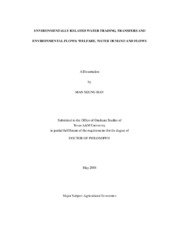| dc.description.abstract | This dissertation reports on economic studies of Texas Interbasin Water Transfers
(IBT) as a way to lessen expected water shortages, Texas minimum freshwater inflows
requirements (FWIB) to protect environmental flows and the general policy setup when
generators of environmental commodities might be able to sell credits in multiple
markets. The Texas-based studies address economic, hydrological and environmental
impacts, focusing on welfare gain, water demand, environmental flows and
complementary relationship of environmental commodities.
Conduct of the two Texas studies required development of a Texas surface water
model. The developed model incorporates: (a) uncertain weather patterns and supply of water; (b) river flows in most of the Texas river basins - twenty-one basins excluding
only the Rio Grande; (c) demand for water by agricultural, municipal and industrial/
mining water; (d) IBT possibilities; (e) evaporation losses; and (e) return flows across
the modeled basins.
In studying the interbasin water transfers, three IBT projects where chosen as
economically justified relocating water largely for municipal and industrial/mining uses.
These IBT projects had the effect of increasing water use and instream flows in the IBT
destination basins, but decreasing those in the source basins.
In studying the freshwater inflows the study revealed that the suggested inflow
constraints were met on average and that the inflow levels for two basins had to be
lowered for the constraints to be feasible. This suggests that the contemplated limits are
too high and that either multiple basin or flow dependent limits need to be developed.
The results also showed that under the average FWIB constraints and IBT
implementation, welfare loss from the FWIB constraints was greatly reduced due to the
IBT projects which were simultaneously implemented.
In the study of multiple environmental commodity markets, the results indicate
that generated credits should be sold in multiple markets only when market caps are set up close to socially efficient (so called first-best) caps: this implies that marginal benefit
curves are very steep. However, restricting selling into just single market achieved the
same net benefits as multiple markets did when market caps were set up at levels less
than the first-best caps. | en |


